How to humidify the air without a humidifier in an apartment in winter: the best practical options
Dry air causes a stuffy nose, a sore throat, a cough, cracked lips, electrified hair, peeling skin... Do you agree that you want to get rid of such unpleasant phenomena as quickly as possible?
Knowing how to humidify the air without a humidifier in your apartment, you will forget about these problems once and for all. Moreover, you will be able to maintain a comfortable microclimate in your home, regardless of the time of year and the weather outside.
In the article we present you will find comprehensive answers to questions that interest the caring owner of a house or apartment. We will talk about the reasons for the decrease in humidity in enclosed spaces. We'll tell you how best to deal with low humidity and related phenomena.
The content of the article:
Why is the air dry and humid?
A person breathes air that contains water vapor. The actual amount of this vapor in one cubic meter of air is called absolute humidity. Abbreviated: ABB. For example, if one cubic meter of air contains 15 g of water, then the absolute humidity is 15 g/m3.
The amount of water in the air varies, but there is a maximum possible saturation of air with water vapor at a given temperature.This value is called maximum absolute humidity, saturation limit or moisture capacity.
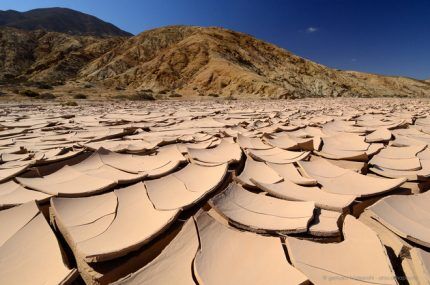
The moisture capacity of air depends on its temperature: the higher the temperature, the more water the air can hold. As the temperature drops, it passes the dew point and the air can no longer hold the same amount of water vapor.
“Excess” moisture condenses and falls out in the form of dew, frost or frost. As a result, the current absolute humidity decreases.
As the temperature rises, the reverse process occurs—an increase in moisture capacity. In the presence of sources of water or steam, humidity will increase to the saturation limit characteristic of a given temperature.
What is relative humidity?
Weather forecasts use relative air humidity (RH) rather than absolute air humidity. This is the ratio between current and maximum absolute humidity multiplied by 100. It is measured not in grams per cubic meter, but in percentage.
It is very important to understand that in winter, with the same AVV outside and in a heated room, the AVV will be higher where the temperature is lower, that is, outside.
Let's look at what this looks like in practice. At −20 °C there can be no more than 0.88 grams of water vapor in 1 cubic meter of air. This is the saturation limit at which the relative humidity is 100%.
At +20 °C the amount of steam in one cubic meter of air can already reach 17.15 g/m3. With the current ABB equal to 0.88 g/m3, the GER will be only 5.1%.

It would seem, why introduce two similar concepts: relative and absolute humidity. But there are good reasons for this. Firstly, it is much easier to measure RHV - even simple household hygrometers do an excellent job of this task.

And secondly (and most importantly), the degree of influence on the body is determined by the combination of humidity and temperature, which means that the RHV indicator is more informative. Remember how uncomfortable it can be on a hot day after rain, when a sauna effect occurs. With moderate humidity, heat is much easier to bear.
Relative humidity according to GOST
Options microclimate in living rooms specified in GOST 30494-2011. They are classified into optimal and acceptable.
An optimal microclimate is one in which the human body is able to maintain a normal thermal state without undue stress on the thermoregulatory mechanisms. With an optimal microclimate, about 80% of people in the room feel comfortable. But the remaining 20% will be uncomfortable.
With acceptable microclimate parameters, the body’s thermoregulation mechanisms are strained, which is why a person’s well-being worsens, he feels discomfort, but without harm to health.
Let us clarify that these standards were developed for builders and organizations servicing residential buildings (housing offices, homeowners' associations, etc.).Therefore, microclimate parameters are indicated in relation to the cold and warm periods of the year. That is, builders must build houses so that they maintain heat and humidity at an acceptable level, and service organizations ensure sufficient heat supply in winter.
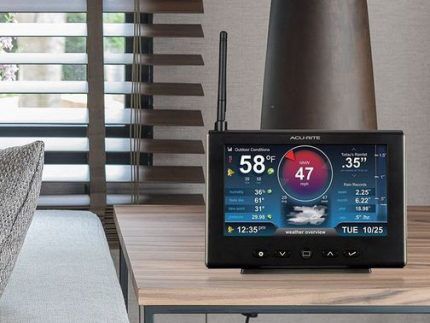
But interrelated indicators of temperature and relative air humidity are important for the human body, regardless of the time of year. What they should be is shown in the table.
| Optimal air temperature | Optimal relative humidity | Maximum permissible relative humidity |
| 20-22 °C | 45-30% | no more than 60% |
| 22-25 °C | 60-30% | no more than 65% |
As you can see, the range of parameters is very wide and when the temperature rises by only 2-3 °C, the upper limit of optimal humidity immediately “jumps” up. It is clear that, despite the standards, an increase or decrease in humidity by 1.5-2 times at a constant temperature will affect well-being.
Even when approaching the lower limit of normal, the air is perceived by many as too dry. If the temperature outside remains −20 °C or lower for a long period, then the relative humidity in apartments drops below the maximum level and can reach 5-7%.
Why is dry air harmful to humans?
Muconasal secretion, secreted by the mucous membranes of the nasal cavity, acts as a barrier to the penetration of viruses and bacteria dangerous to humans into the body.
With a lack of humidity in the air, the mucous membranes dry out, and a lack of secretion occurs, which contributes to infection with influenza and other infectious diseases. A runny nose, sneezing, and coughing appear. Due to dryness and tension, microcracks form on the mucous membranes, which can become foci of purulent infections.
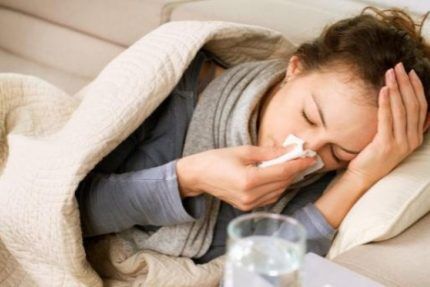
Being in a room with low humidity causes tears to dry out quickly. The surface of the eyes is not cleaned or moistened properly. Itching and redness appear. People who work at a computer or wear contact lenses are most affected.
From dry air suffer not only mucous membranes, but also the skin. Dry skin is more prone to allergic reactions and dermatoses. General well-being also worsens, a person gets tired faster and perceives information worse.
Young children are most sensitive to dry air. Doctors recommend maintaining relative humidity in the nursery at a level of at least 45-50%.
How to determine whether the air is dry or not?
The easiest way to control the microclimate is with the help of instruments: a thermometer, hygrometer or home weather station. You can also use improvised means.
Fill the glass with water and place in the refrigerator to cool to 3-5 °C. Remove the glass of cold water and place it on a table or other surface that is convenient for observation.
After 10 minutes, assess the condition of the condensation on the outer wall of the glass. Small drops of water on the fogged wall indicate normal humidity. Large drops flowing down the wall indicate high humidity.If there is no condensation, the outside of the glass is dry - the humidity is low.

A fresh pine cone, just picked from a tree or recently fallen off a branch, reacts to the moisture content in the air. When brought into an apartment where the air is too dry, it fully reveals its scales. At high humidity, on the contrary, the scales will remain pressed. Just do not place the pine cone near heat sources, otherwise the observation results will be unreliable.
We must also remember that the sensation of cold and warmth is purely individual. Some people walk around the house in just a T-shirt even at 18°C. For others, central heating radiators seem cold, despite the optimal 22 °C. Therefore, you need to focus on your own feelings and well-being.
But if the effects mentioned at the beginning of the article occur, while electric heaters are working, the apartment is often ventilated when it is -10 ° C or lower outside, and the tips of the leaves of house plants, despite proper care, dry out - it’s time to act.
You don't have to buy special equipment for this. It is well known how you can humidify an apartment in winter without a humidifier using folk methods, which at the same time have a scientific basis.
How to properly increase humidity?
By understanding the relativity of humidity under different conditions, you will no longer make the common mistake of trying to humidify your apartment by ventilating in winter. If it is frosty outside and high relative humidity, ventilation will have the exact opposite effect and the air will become even drier.
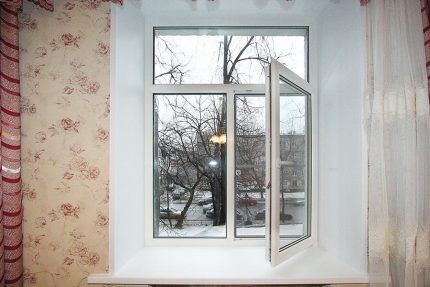
Also, do not reduce the heat supply or cover the radiator with a blanket to lower the temperature in the apartment. The relative humidity will indeed increase, but the actual amount of moisture in the air will not change, although this is precisely our goal.
It may seem that the limited moisture capacity of the air causes nothing but trouble. In fact, thanks to this property, the Earth’s atmosphere, saturated with water vapor, does not boil and does not turn into an ice block, and to humidify too dry air in the apartment there is simple and effective methods.
Using water containers
On the sea coast there is always more moisture in the air, but it will not be possible to create a large pond in an apartment. But you can place containers of water in different places. As it evaporates, it will continuously humidify the air.
You can pour water into a basin, a refrigerator tray, a large dish, the main thing is that the evaporation surface is as large as possible. Bottles and other containers with narrow necks are not suitable for this purpose.
To avoid tripping over dishes placed around the apartment, place them under the table, under the radiator, under the cabinet or in other hard-to-reach places. Don't forget to add water as it evaporates.
Moisturizing curtains and towels
Heating radiators in standard apartments are located under the windows behind the curtains. Using a spray bottle, wet the curtains with water until slightly damp. The heat emanating from the battery will dry the fabric, evaporating the water. The method is most effective if heavy, moisture-absorbing curtains are used as curtains.
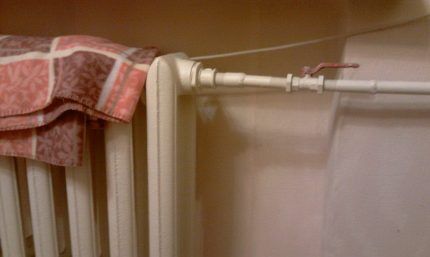
Terry fabric, from which bath towels and robes are made, absorbs and retains water well. Wet a terry towel with water, wring it out lightly and hang it on the back of a chair or radiator. After the towel has dried, repeat the procedure.
Plastic bottle and bandage
You will need a 1 liter plastic bottle and a regular bandage 1-2 meters long. One end of the bandage is rolled into a rope and passed through the neck of the bottle to the very bottom. The bottle is filled with water and fixed to the battery, for example, using a strong rope. The outer part of the bandage is wrapped around the battery.
The bandage will be saturated with water from the bottle and evaporate this moisture under the influence of heat emanating from the battery, humidifying the air. You just need to remember to add water to the bottle.
Moisture-loving house plants
Houseplants with large leaves retain a lot of liquid and humidify the air well.
Best suited for this purpose:
- ficus and scindapsus;
- monstera and nephrolepis;
- aglonema and diefenbachia;
- Sansevieria and Chlorophytum.
Moisture-loving plants require regular, abundant watering and spraying.
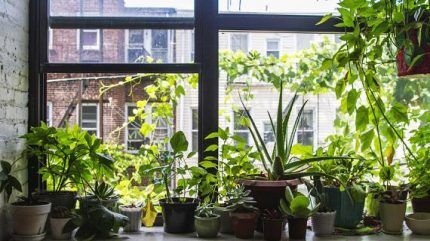
Moist soil in pots will serve as another natural humidifier. In addition to humidification, plants purify the air from formaldehyde and other harmful substances and enrich it with oxygen.
Indoor table fountains
Small tabletop indoor fountains can be with or without a submersible pump. Water rises to the top and flows down, passing a path of varying complexity and length.
During circulation, natural evaporation of water occurs, due to which the air is saturated with moisture. Such fountains are a fashionable decorative element. The murmuring of the jets promotes relaxation.
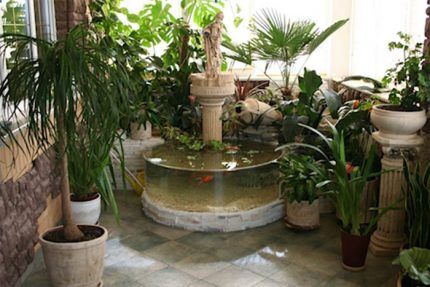
To prevent limescale deposits, use distilled water. It needs to be topped up daily, preventing the fountain from running idle. Clean and flush the fountain every 1-2 months.
Pebbles or expanded clay against “dryness”
A wide, shallow container is filled halfway with small pebbles or expanded clay and water is poured in, subsequently topping it up as it evaporates. You can place pots of Usambara violets on a tray with pebbles and place them all together on a windowsill or on a kitchen cabinet if there is a sufficiently sunny place.
Pebbles should be washed regularly under running water. It is also useful to periodically sterilize it by immersing it in boiling water for several minutes.
Filling aquasoil into a container
Colored balls that can absorb water and then gradually release it to the soil or atmosphere are called aquasoil. It is used in floriculture, adding to pots with house plants. It also looks beautiful in vases with cut flowers.
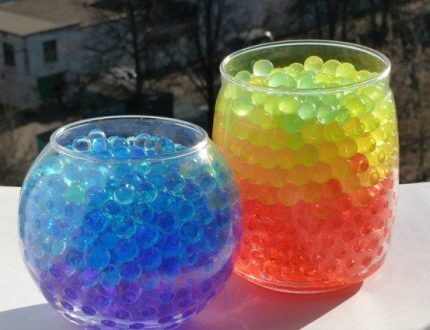
If you spread the aqua soil into vases and salanits, it will not only humidify the air in the apartment, but also decorate the interior. Stir the balls periodically so that not only the top but also the bottom layer evaporates moisture, and also add water. Once a week, give the balls a shower - rinse them under running water.
Aquarium with or without fish
Large and small transparent containers of water are excellent helpers in the fight against dry air. Tabletop, floor-standing, wall-mounted, round, rectangular, multi-faceted aquariums are beautiful, fashionable, interesting.
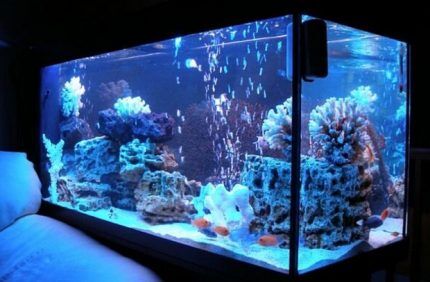
If you do not have the opportunity or desire to care for the inhabitants of your home pond, do without them. With such an aquarium, you will not have to waste time caring for fish and plants. For decoration, use colored soil, models of castles and coral reefs, and don’t forget about lighting. Do not cover the aquarium with a lid so that the water constantly saturates the air in the room with moisture.
Steam from hot water
There are situations when it is urgent to humidify the air. Boiling water in a kettle or open pan will quickly saturate the air with steam. This method can only be temporary, since it is easy to forget that the stove is on. In order not to create a steam room in the kitchen, the fire under the pan should be minimal.
After taking a bath or shower, do not allow moisture to leave your apartment through the ventilation - open the door in the bathroom and let the air in the living rooms become saturated with moisture for a short time.
Don't overdo it in the fight against dryness.Relative humidity above 70% will lead to dampness of the walls and ceiling, and this is already a favorable environment for the development of mold. Dampness in the house is much more dangerous to health, so avoid extremes and stick to the “golden mean”.
If you think the methods listed in the article are not very effective and you want to independently control the process of saturating the atmosphere in the room with water, it is worth purchasing humidifier, the features of the choice of which will be introduced in our proposed article.
Conclusions and useful video on the topic
5 practical ways to increase air humidity in an apartment:
How to effectively use a towel to combat excessive dryness in your home:
Humidification, purification and aromatization of air:
Human health and well-being depend on the relative humidity of the air. In winter, the moisture content in the air may fall below acceptable standards, which requires normalization of the microclimate. It is not necessary to use special devices for this.
You can make do with improvised means that have varying degrees of effectiveness. A combination of different methods helps to achieve a lasting effect and make the home more comfortable.
Do you have useful information on the topic of the article? Do you want to share it with site visitors? Write comments, ask questions, post photos in the block form below.



